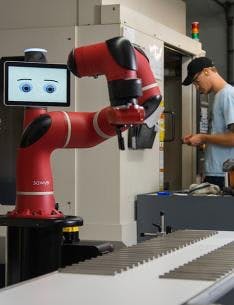Your new coworker, Baxter, makes a frowny face when a task confuses him. The other
new hire, Sawyer, indicates excitement by raising his eyebrows. Both work tirelessly, never pausing to use the bathroom or sneak out back for a cigarette.
These new coworkers are robots, of course, complete with digital “eyes” that display “emotions” related to job performance, which can come off a little “spooky.”
The digital peepers on these advanced machines serve other purposes, too. Movement of the eyes precedes movement of the robots’ arms, which provides humans working alongside them a moment of warning before the metallic limbs swing through the air. And the digital displays double as HMIs, enabling you to input info or extract data from the robot during downtime.
These modern marvels are the handiwork of Rethink Robotics, a Boston-based manufacturer of highly skilled—if completely soulless—workers. And rather than touting how advanced their machines are, the company’s marketing message for Baxter and Sawyer is that they’re actually quite basic. They’re easy to program and flexible enough to be assigned to multiple tasks—operating a lathe in the morning, assembling parts in the afternoon, then rolled over to the packaging bay at night. These robots can operate in unstructured environments, not bolted down to one station like their ancestors. They can easily adapt to different assignments, akin to a human worker. And they’ll be able to learn the same way, too. The next step—and it ain’t that far away—is robots ably replicating behaviors shown to them by their human bosses. Zero programming. Zero code. The robot simply “watches” someone perform a task, then replicates it.
“Robots have been dumb. They do just what you tell them to do,” says Jim Lawton, chief product & marketing officer of Rethink Robotics. “We figured that if we could add more logic to them, robots could get smarter. They could learn from their experience and share that knowledge with other robots.”
Lawton actually prefers the term “cobot,” an abbreviation for “collaborative robot.” (Not to be confused with GoBots, which was an abbreviation for “Transformers knockoff.”) Cobot sounds warmer, too. Less threatening. More chummy. “Let’s get a beer after our shift, Baxter.”
The Rethink Robots team envisions their machines at work in every type of facility. Wherein robots traditionally were so expensive that only industrial giants could afford them, the modern mechanical man is (relatively) cheap. “Anybody that has a job shop can afford these,” claims Lawton, who notes that robots—being essentially a “big bucket of sensors”—can produce mountains of efficiency-boosting data, thus helping to pay for themselves.
When asked the big question—Do robots steal jobs from the working class?—Lawton notes how domestic manufacturers are already struggling to find qualified people to fill these roles. “Millennials don’t want manufacturing jobs,” he posits. “There are too many other cool things to do.” Likewise, competition demands that businesses get on board. “Humans are—relatively speaking—imprecise,” he says. “If I have a factory full of robots and you don’t, my robots are going to win.”
You gotta respect that blunt mindset, particularly as it complements the company name—Rethink Robotics—which addresses, head-on, the reluctance some have about the impending robotic wave and the reflexive response humans have to encountering machines with “our” traits.
The business benefits are irrefutable. Those digital peepers on Baxter and Sawyer never droop with fatigue. They’re not bloodshot the day after the Super Bowl. Those eyes don’t wander when a sexy new robot rolls across the factory floor.
But do human elements applied to machines really foster collaboration and then, ultimately, increase overall efficiency? Or are these lifelike features spooky as hell, particularly when they’re attached to automatons that might take your job?
That’s what some workers on the plant floor undoubtedly think. And that’s what people at the forefront of robotics want us to rethink.





